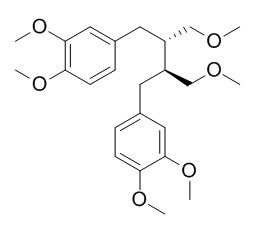Phyllanthin
Phyllanthin is widely used as hepatoprotective and antigenotoxic and inhibit function of P-gp.
Inquire / Order:
manager@chemfaces.com
Technical Inquiries:
service@chemfaces.com
Tel:
+86-27-84237783
Fax:
+86-27-84254680
Address:
1 Building, No. 83, CheCheng Rd., Wuhan Economic and Technological Development Zone, Wuhan, Hubei 430056, PRC
Providing storage is as stated on the product vial and the vial is kept tightly sealed, the product can be stored for up to
24 months(2-8C).
Wherever possible, you should prepare and use solutions on the same day. However, if you need to make up stock solutions in advance, we recommend that you store the solution as aliquots in tightly sealed vials at -20C. Generally, these will be useable for up to two weeks. Before use, and prior to opening the vial we recommend that you allow your product to equilibrate to room temperature for at least 1 hour.
Need more advice on solubility, usage and handling? Please email to: service@chemfaces.com
The packaging of the product may have turned upside down during transportation, resulting in the natural compounds adhering to the neck or cap of the vial. take the vial out of its packaging and gently shake to let the compounds fall to the bottom of the vial. for liquid products, centrifuge at 200-500 RPM to gather the liquid at the bottom of the vial. try to avoid loss or contamination during handling.
J Ethnopharmacol.2022, 291:115159.
J Ethnopharmacol.2019, 241:112025
J Adv Res.2019, 17:85-94
Food Chem.2016, 191:81-90
Sci Rep. 2017, 17332(7)
Molecules.2023, 28(19):6767.
Eur J Pharmacol.2022, 917:174744.
Food Hydrocolloids2024, 152:109898
Processes2023, 11(2), 385��
CZECH MYCOLOGY2021, 73(1):1-19.
Related and Featured Products
J Pharm Pharmacol. 2013 Feb;65(2):292-9.
Phyllanthin and hypophyllanthin inhibit function of P-gp but not MRP2 in Caco-2 cells.[Pubmed:
23278697]
The purposes of this study were to investigate the inhibitory effects of two lignans, Phyllanthin and hypoPhyllanthin, on the function of P-glycoprotein (P-gp) and multidrug resistance protein 2 (MRP2), using the in-vitro model of Caco-2 cells. In addition, the effect of prolonged exposure to these two compounds on the expression of active P-gp was also determined.
METHODS AND RESULTS:
The activity of P-gp and MRP2 was determined in the uptake assays by monitoring the intracellular accumulation of their specific substrates (calcein acetoxymethyl ester and 5(6)-carboxy-2',7'-dichlorofluorescein diacetate, respectively) with fluorescence spectroscopy.
HypoPhyllanthin and Phyllanthin inhibited P-gp function with comparable potencies, but neither compound affected MRP2 activity. When the lignans were washed out before addition of substrate, the inhibitory action of both compounds against P-gp function was lost. These results suggested the reversibility of the inhibition. Moreover, prolonged exposure of the Caco-2 cells to both lignans (up to 7 days) had no effect on P-gp function.
CONCLUSIONS:
Phyllanthin and hypoPhyllanthin directly inhibited P-gp activity and did not interfere with MRP2 activity. It was likely that both Phyllanthin and hypoPhyllanthin could reversibly inhibit P-gp function.
Chem Biol Interact. 2009 Oct 30;181(3):351-8.
Isolation, characterization and antioxidative effect of phyllanthin against CCl4-induced toxicity in HepG2 cell line.[Pubmed:
19576190]
The present study was an attempt to investigate the hepatoprotective and antioxidative property of Phyllanthus amarus (P. amarus) extract and Phyllanthin.
METHODS AND RESULTS:
Phyllanthin, one of the active lignin present in this plant species was isolated from the aerial parts, by silica gel column chromatography employing gradient elution with hexane-ethyl acetate solvent mixture. It was obtained in high yields (1.23%), compared to reported procedures and the purity was ascertained by HPTLC and reversed-phase HPLC analysis. Characterization of Phyllanthin was done by mp, UV-Visible spectrophotometry, elemental analysis, FT-IR, 1H NMR, 13C NMR and mass spectral analysis. Free radical scavenging activity of P. amarus extract and Phyllanthin was also examined using DPPH assay. The protective effect of P. amarus extract and Phyllanthin was studied on CCl4-induced toxicity in human hepatoma HepG2 cell line.
CONCLUSIONS:
The results indicated that CCl4 treatment caused a significant decrease in cell viability. In addition, the toxin treatment initiated lipid peroxidation (LPO), caused leakage of enzymes like alanine transaminase (ALT) and lactate dehydrogenase (LDH) with a significant decrease in glutathione (GSH) levels. It was observed that Phyllanthin effectively alleviated the changes induced by CCl4 in a concentration-dependent manner, with much smaller strengths as compared to P. amarus extract.
Toxicol Ind Health. 2014 May 9.
Phyllanthin inhibits CCl4-mediated oxidative stress and hepatic fibrosis by down-regulating TNF-α/ NF-κB and pro-fibrotic factor TGF-β1 mediated inflammatory signaling.[Pubmed:
24817434]
Hepatic fibrosis is an important outcome of chronic liver injury and results in excess synthesis and accumulation of extracellular matrix (ECM) components. Phyllanthin (PLN) isolated from Phyllanthus amarus exhibits strong antioxidative property and protects HepG2 cells from carbon tetrachloride (CCl4)-induced experimental toxicity.
METHODS AND RESULTS:
The present study reports the antifibrotic potential of PLN. The in vivo inhibitory effect of PLN on CCl4-mediated lipid peroxidation and important profibrotic mediator transforming growth factor β1 and on predominant ECM components collagen and fibronectin were also studied.
CONCLUSIONS:
The results show that PLN acts by suppressing the expression of inflammatory cytokine tumor necrosis factor-α and prevents activation of nuclear factor-κB in hepatic tissue. Our study highlights the molecular mechanism responsible for the antifibrotic efficacy of PLN.



